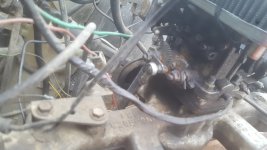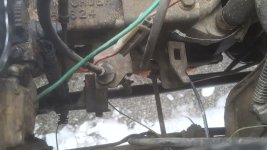Agree that a compression test should performed to determine the engines health .
Also , test the intake manifold for intake leaks at the base gasket where the carb bolts up but more in particular where the intake bolts up to the cylinder head . In - line engines are known for intake leaks there . You can try to retorque the intake hold down fasteners to see if improvement is found which would indicate a possible worn gasket but at least loose gasket seal.
it would be best to soak the fasteners with penetrating oil first and allow time to soak in before attempting to tighten . If any of the nuts and bolts are frozen , you can snap a fastener trying to torque them . I would like to suggest tuning in the idle mixture screws for highest vacuum reading and even setting for proper synchronization of the fuel / air mixture being drawn from each side of the carb to ensure the carburetor is feeding the engine well . Equal turns out from seated position is proper sync and steady vacuum reading is desirable.
before tuning can be done however , vacuum leaks will have to be checked for and corrected or any tuning attempts of the carb will be fruitless . You will no doubt have to obtain a vacuum gauge . A good tachometer may be helpful as well to ensure the engine is idling at correct rpm for carb setting and timing. A vacuum tests readings will be your first concern .
If your engine is idling poorly but dosen't stall until you accelerate , it may be an intake gasket seal problem . In short spurts , squirt penetrating oil where carb bolts on to intake and where intake bolts to cylinder head . If a leak exists , a short climb in rpm will be detected .
also , fuel pressure should be checked to ensure proper fuel delivery.
a fuel pump that won't keep the float bowl at a proper level will cause fuel starvation .
a vacuum gauge will be helpful to check if proper fuel draw is being obtained from fuel tank and a volume test would need to be performed if fuel pump output is suspected to be poor . That just involves removing the line from the carb and filling a glass jar a measuring volume and time it takes to fill jar . Steady flow is most important for good pressure and delivery .
It is also possible the carb float may be stuck . If it were stuck open , carb would be flooding . Overflow would be seen . If float were stuck closed and fuel just barely enters float bowl forcing past float needle , float bowl not being adequately filled and miss during acceleration ( and stalling ) may be due to low fuel pressure / volume . The carbs accelerator pump can't draw enough fuel if float chamber isn't full and can't push fuel through its passages to help accelerate engine .
Before suspecting any carb problems or attempting adjustment , look for vacuum leaks first .
then , once vacuum reading is satisfactory and stable , ignition timing and carb adjustment can be performed . No tuning can be done until the engines health is determined via compression test and vacuum reading tests are first performed . Hope this helps . Please post results when you can .
if timing light reading is erratic , it could be worn timing chain which affects idle and acceleration due to late valve timing which effects engine vacuum , in addition to vacuum leaks .
Check for timing chain wear . With engine off , carefully turn engine damper / harmonic balancer with a breaker bar and watch distributor rotor . If balancer moves and rotor delays to rotate until balancer is rotated conciderably , a worn timing chain is evident .


